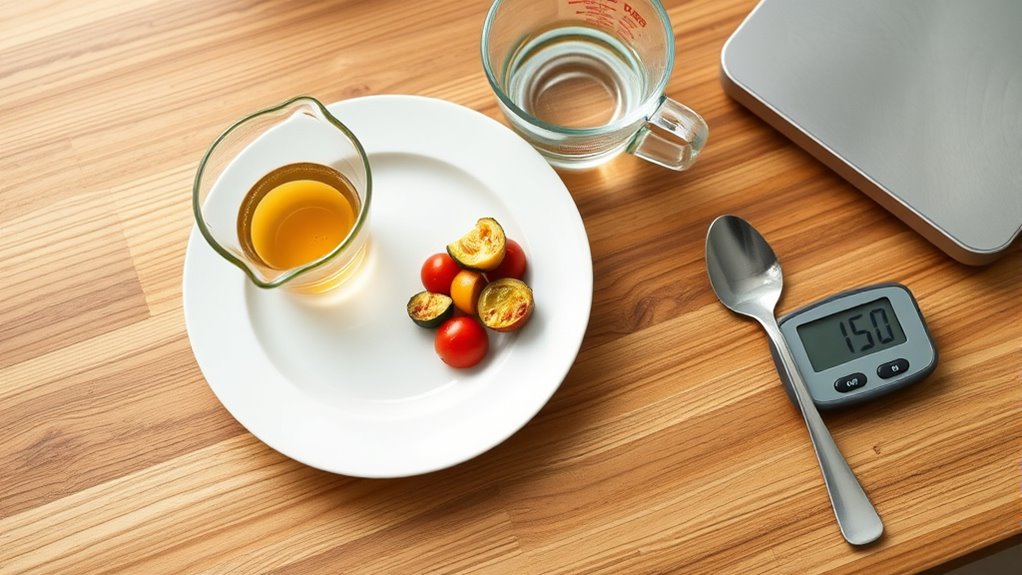To master portion control when cooking for one, use smaller plates and bowls to make your servings look satisfying, measure ingredients precisely, and prepare single-serving recipes with small cookware. Store leftovers in proper portions to prevent waste, fill your plate with vegetables for volume and nutrients, and practice mindful eating to savor each bite. Batch cook and freeze in controlled portions, and adjust recipes for one to avoid leftovers. Keep exploring—more tips await you.
Key Takeaways
- Use smaller plates and bowls to visually promote full portions and prevent overeating.
- Measure ingredients carefully and prepare single-serving recipes to control portion sizes precisely.
- Store leftovers in pre-measured containers to reduce waste and simplify future meals.
- Incorporate a variety of vegetables to add volume and nutrients without extra calories.
- Practice mindful eating by paying attention to hunger cues, savoring food, and eating slowly.
Use Smaller Plates and Bowls

Using smaller plates and bowls is an effective way to naturally limit your portion sizes. When you choose a smaller plate, it visually looks full with less food, helping you feel satisfied without overeating. Pay attention to your plate size; a standard dinner plate might encourage larger servings, while a smaller one promotes moderation. Similarly, bowl selection plays a key role—opt for smaller bowls to control snack or cereal portions easily. This simple switch tricks your brain into thinking you’re eating more than you actually are. Consistently using smaller dishes encourages better portion control, making it easier to stick to your goals. Over time, this habit helps prevent overeating and supports healthier eating patterns without feeling deprived. Additionally, understanding the importance of visual cues in portion control can further enhance your ability to manage intake effectively.
Measure Ingredients Carefully
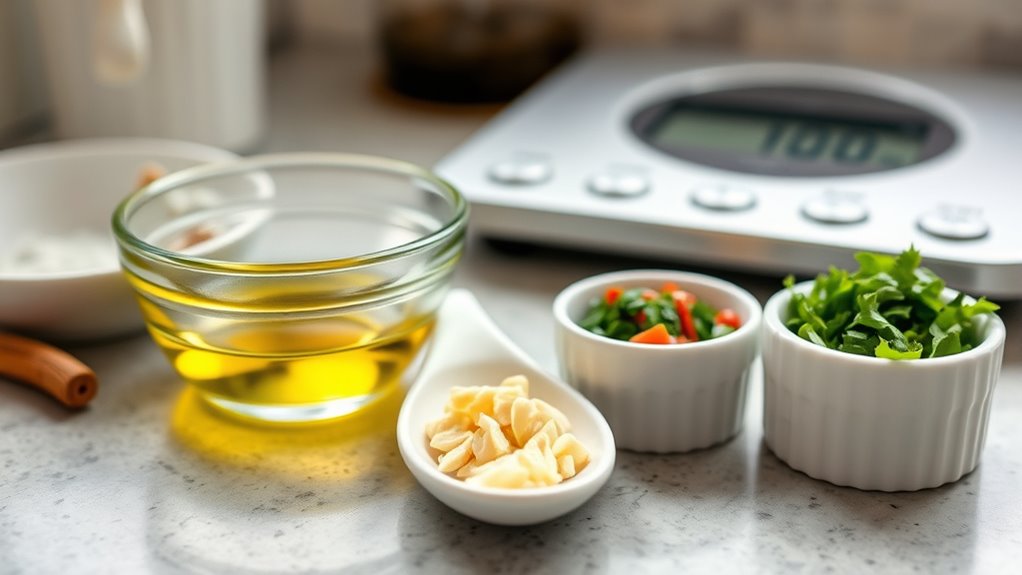
Using measuring cups helps guarantee you add the right amount of each ingredient. Be sure to level off ingredients for accuracy, especially with powders and spices. Avoid heaping measurements, as they can easily lead to larger portions than intended.
Use Measuring Cups
Ever wonder how to guarantee your portions stay just right? Using measuring cups is a simple way to assure portion control when cooking for one. Instead of eyeballing ingredients, grab a set of measuring cups to accurately measure liquids, grains, and other ingredients. This helps prevent overloading your plate and keeps your meal balanced. When you measure carefully, you’ll also reduce waste and avoid unnecessary calories. Keep a set handy in your kitchen so you can quickly and consistently portion out ingredients. Remember, even small differences in measurements can add up over time, affecting your goals. Using measuring cups makes it easier to stick to your planned portions, making your cooking both precise and healthy. It’s a straightforward step towards smarter portion control.
Level Ingredients Precisely
Measuring your ingredients carefully guarantees each meal is just right, preventing both waste and overeating. Precise measurements ensure nutritional accuracy, helping you control calorie intake and balance nutrients. Use flat-edged tools like a knife or a leveler to level off dry ingredients, avoiding excess that can skew recipes. When substituting ingredients, measure accurately to maintain the recipe’s intended flavor and texture. For example, swapping one type of flour for another requires adjusting quantities to match nutritional content and consistency. Accurate measurement prevents over- or under-seasoning, ensuring your dish tastes as intended. By carefully leveling ingredients, you keep your portions consistent, which supports your portion control goals and makes meal prep more predictable and satisfying. Incorporating natural materials and rustic decor elements can also help you create a cozy, farmhouse-inspired kitchen environment that encourages mindful eating.
Avoid Heaping Measurements
Heaping measurements can lead to inconsistent portions and unintended calorie intake. When measuring ingredients, avoid piling them over the line; instead, level off each measurement for accuracy. Using proper measuring tools ensures you get the right portion sizes every time. To help visualize, here’s a simple comparison:
| Heaping Measurements | Level Measurements | Accurate Portions |
|---|---|---|
| Overflowing spoon | Flat spoon | Precise amount |
| Mounded cup | Filled to rim | Correct portion |
| Piled on a plate | Even layer | Consistent size |
Additionally, incorporating unique and wicked planters can make your cooking space more inspiring, encouraging healthier habits and creativity in your meal preparations.
Prepare Single-Serving Recipes
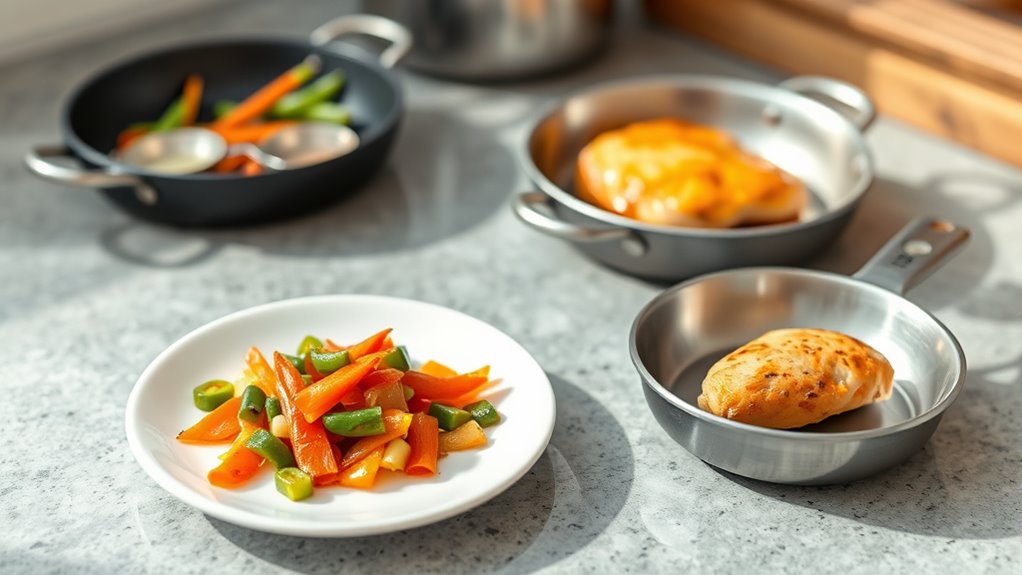
Using small cookware helps you control portions easily and prevents overeating. Measure your ingredients carefully to guarantee each recipe stays single-serving. Together, these tips make cooking for one simple and satisfying. Additionally, experimenting with virtual cooking classes can enhance your skills and inspire new single-serving recipes.
Use Small Cookware
Opting for small cookware is one of the simplest ways to control portion sizes when cooking for yourself. Smaller pots and pans naturally limit how much you cook, reducing leftovers and overeating. When choosing cookware materials, consider non-stick surfaces for easy cleanup and even heat distribution, which enhances your cooking techniques. Using small cookware encourages you to focus on single-serving recipes, making meal prep straightforward.
- Use a mini skillet for single-serve breakfast hashes or omelets.
- Choose compact saucepans for sauces or side dishes.
- Opt for small baking dishes for individual casseroles or desserts.
Measure Carefully
To effectively control portion sizes, you need to measure ingredients carefully when preparing single-serving recipes. Precise measuring boosts your portion awareness and helps you stay on track with calorie counting. Use measuring cups and spoons to guarantee accuracy, especially with ingredients like oils, sugars, and flour. Weighing items with a kitchen scale offers even greater precision for proteins and produce. By paying close attention to measurements, you avoid unintentionally oversized portions that can lead to overeating. This practice helps you develop a better understanding of appropriate serving sizes, making it easier to manage your calorie intake. Consistent measuring also ensures your recipes turn out as intended, providing satisfying meals without excess. Incorporating the use of butter in your recipes can enhance flavor and texture, making portion control both enjoyable and flavorful. Mastering this simple step keeps your portion control sharp and supports your overall health goals.
Store Leftovers in Proper Portions
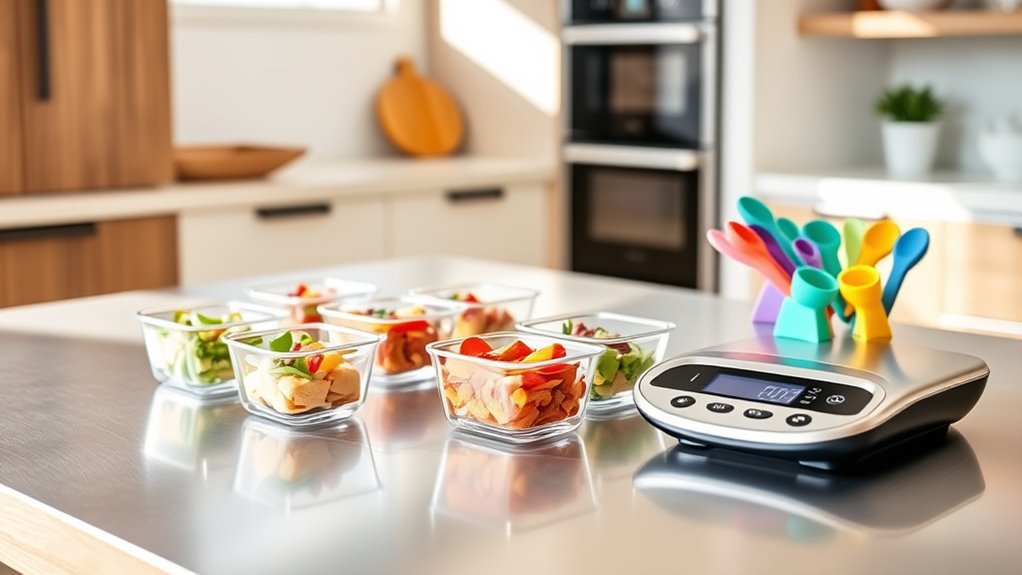
Storing leftovers in proper portions helps you avoid waste and makes future meals more convenient. Using appropriate portion sizing guarantees you don’t have too much or too little leftover food. When storing, consider these tips:
- Divide leftovers into meal-sized containers to prevent over-portioning.
- Use airtight containers to keep leftover storage fresh longer.
- Label containers with dates to track freshness and avoid spoilage.
- Refer to optimal angles to ensure proper placement and storage of food items, preventing damage and spoilage.
Incorporate Vegetables to Fill Your Plate

Adding vegetables to your plate not only boosts nutrition but also helps control portion sizes naturally. Filling your plate with a vegetable variety adds volume and flavor enhancement without excess calories. This strategy guarantees you feel satisfied while eating less. To maximize benefits, choose colorful vegetables like bell peppers, spinach, and carrots, which provide different textures and nutrients. Incorporating a range of vegetables keeps meals interesting and prevents boredom. Use the table below to understand the importance of variety and flavor:
| Vegetable Type | Nutritional Benefits | Flavor Enhancement |
|---|---|---|
| Leafy greens | Vitamins A & C | Mild, fresh taste |
| Root vegetables | Fiber, antioxidants | Earthy, sweet |
| Cruciferous | Detox support | Slight bitterness |
| Nightshades | Vitamin C, antioxidants | Rich, savory |
| Alliums | Immune support | Pungent, aromatic |
Additionally, vegetable diversity can contribute to better overall satisfaction with your meals.
Practice Mindful Eating

Practicing mindful eating means paying full attention to your food and the experience of eating, rather than rushing through meals or distractedly snacking. When you focus on mindful eating, you become more aware of your portion sizes and how your body feels. This helps you develop better portion awareness, preventing overeating. To do this effectively:
- Savor each bite, noticing textures and flavors.
- Eat slowly, giving your brain time to recognize fullness.
- Minimize distractions like screens or multitasking during meals.
- Incorporate cultural traditions that emphasize mindful and social eating practices, enhancing your overall awareness during meals.
Batch Cook and Freeze in Portions
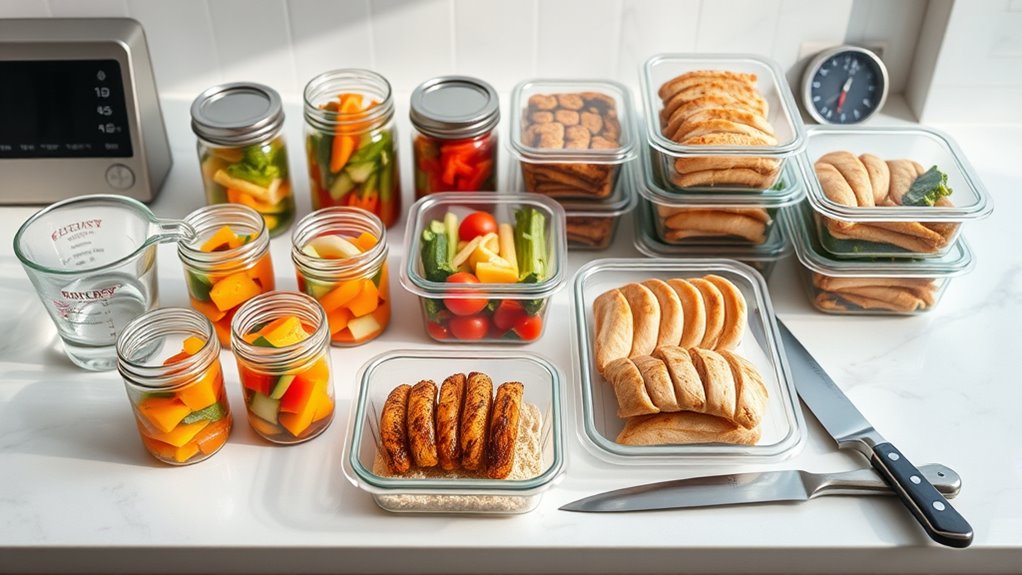
Batch cooking and freezing food in single-serving portions is an effective way to save time and control your intake when cooking for one. It simplifies meal prepping by allowing you to prepare multiple meals at once, reducing daily cooking stress. To keep things organized, use portion labeling on each container or bag, so you know exactly what’s inside and avoid unnecessary waste. When you’re ready to eat, just thaw a portion and reheat, ensuring fresh, homemade meals without extra effort. This method also helps you stick to portion control, preventing overeating. By planning ahead and dividing your dishes into manageable sizes, you’ll enjoy the convenience of pre-made meals that fit your lifestyle and dietary goals. Regularly reviewing your portion sizes and cooking habits can help you stay aligned with your personal goals and maintain a balanced diet.
Adjust Recipes for One Serving
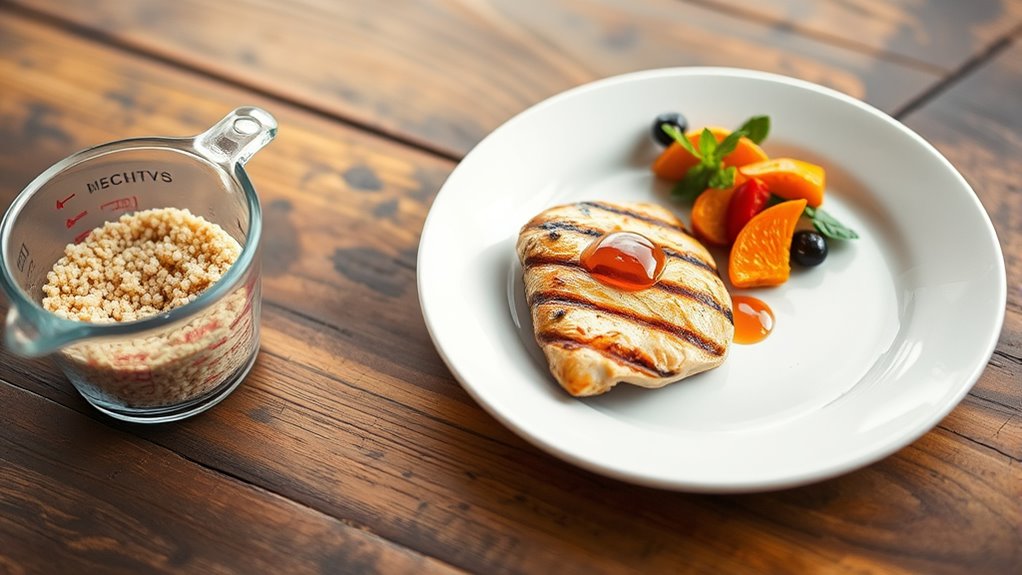
When cooking for one, adjusting recipes to yield a single serving guarantees you don’t end up with leftovers or wasted ingredients. To do this effectively, focus on meal planning to determine exact quantities needed. Use ingredient substitutions to simplify measurements and reduce waste, such as swapping a whole onion for a portioned amount.
Here are some tips:
- Halve or quarter recipes carefully, adjusting seasonings accordingly
- Measure ingredients precisely to avoid overshooting
- Use standard measuring cups or a digital scale for accuracy
Frequently Asked Questions
How Can I Estimate Portion Sizes Without Measuring Tools?
To estimate portion sizes without measuring tools, rely on visual cues and portion estimation techniques. Use your hand as a guide—your palm can represent a serving of meat, and a cupped hand can indicate a handful of snacks. Compare food sizes to everyday objects, like a deck of cards or a tennis ball. These visual cues help you keep portions in check and make mindful eating easier.
What Are Healthy Snack Portion Options for One Person?
Healthy snack ideas balance flavor and portion size, so you stay satisfied without overeating. For portion control tips, opt for small bowls or pre-measured portions like a handful of nuts or veggie sticks with hummus. Fresh fruit, Greek yogurt, or a few whole-grain crackers make great options. This way, you enjoy tasty snacks while keeping your intake in check, making healthy choices easy and enjoyable for one person.
How Do I Prevent Overeating When Cooking for Myself?
To prevent overeating when cooking for yourself, practice mindful eating by paying attention to hunger cues and savoring each bite. Incorporate meal planning to prepare balanced portions ahead of time, reducing the temptation to overserve yourself. Use smaller plates and bowls to help control portions visually. These strategies make it easier to enjoy your meals without overeating, supporting your health goals and making cooking for one more satisfying.
Are There Specific Utensils That Help With Portion Control?
You can use measuring cups and portion plates to help control your servings. Measuring cups allow you to accurately measure ingredients, preventing accidental overeating during prep. Portion plates are designed with sections for different food groups, making it easy to keep your portions balanced. Both tools encourage mindful eating and help you stick to healthier portion sizes, making it easier to avoid overeating when cooking for yourself.
How Can I Reduce Food Waste When Cooking Solo?
When cooking solo, you can’t afford to let food go to waste. Think of it as “a stitch in time saves nine.” Start with meal planning to buy only what you need, and store ingredients properly to extend their freshness. Use leftovers creatively for future meals, and freeze portions for busy days. These habits keep food fresh longer and reduce waste, saving you money and helping the environment.
Conclusion
By blending mindful measures with manageable portions, you’ll master the art of portion control when cooking for one. Small steps, like selecting stylishly small dishes and savoring every bite, make a significant difference. With a bit of batching, balancing, and baking in mindful moderation, you’ll build better habits and boost your body’s balance. Embrace these tricks, and watch your wellness wonderfully widen—making your solo cooking simply satisfying and sustainably savvy.
